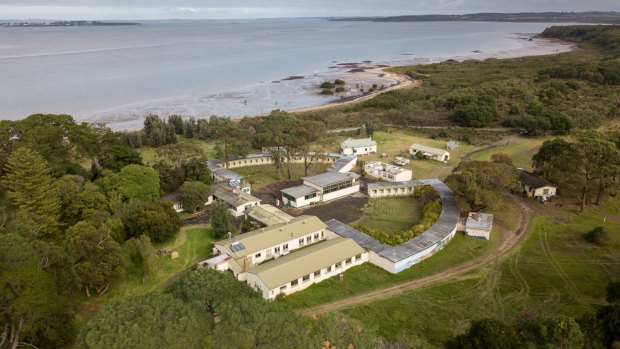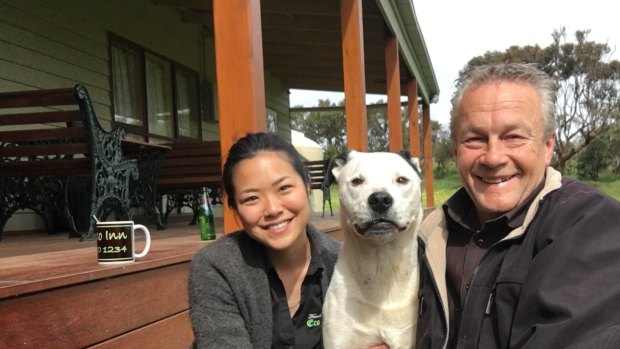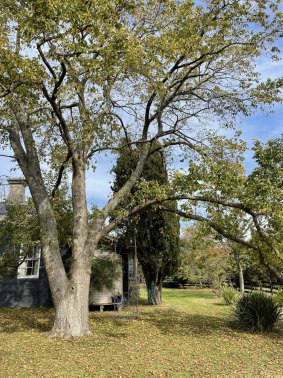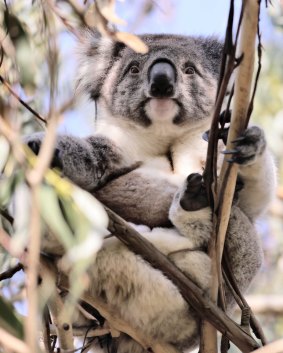This was published 4 years ago
French Island tourism: Victoria’s largest island has few visitors and even fewer residents
By Kylie McLaughlin

McLeod Prison on French Island sold to a Chinese consortium in 2017 for $4 million, but plans to develop the site have so far come to naught. Credit: Jason South
The "moat" that separates Victoria's largest island from the mainland created a welcome barrier for residents during last year's COVID-19 outbreak, but French Island is ready to receive visitors again.
"The COVID situation further reinforced how lucky we are as French Island residents," says Phil Bock, a local for 10 years and owner of the island's Eco Inn.
"The Westernport 'moat' gives us some peace of mind and is a unique barrier to be thankful for."

French Island Eco Inn owner Phil Bock, wife Yuko and dog Sam.
Bock says the island's permanent residents "are quite used to shopping in bulk, so that is nothing new to us, but being confronted with many empty supermarket shelves during the coronavirus panic-buying period was a little concerning. Fortunately, it was a relatively temporary issue."
Twice the size of Phillip Island and accessible only by ferry, the closest island to Melbourne is the furthest from most Melburnians' minds as a holiday destination. Yet French Island's local tour operator, Naturaliste Tours, this month resumed operations following a COVID-19-related shutdown last year.
And it's on an unnaturally sunny May day I'm flee the CBD to board Naturaliste Tours' 4WD bus called Bruce, which can tackle just about anything, including 'the Pinnacle' - a large sand dune and at 65m, one of the island's highest points. The otherwise low-lying island is covered with mostly untouched mangroves, wetlands and woodlands and with its wildlife, abundance of birdlife and wildflowers in the spring, it's truly paradisaical.

Mandalaye Park, a property offering accommodation and function rooms on French Island.Credit: Kylie McLaughlin
Just 61 kilometres from the CBD in Westernport Bay, French Island's 170 square kilometres are home to 110 residents, while two-thirds of the area is national park.
It's this sense of seclusion that draws eco-travellers and celebrities such as Kylie Minogue, who fled here with her then-boyfriend Olivier Martinez while she was recovering from cancer. The Minogue sisters bought their island getaway in 2005 for $400,000, spruced it up and then sold it for more than a million dollars in 2017.
But the island is a somewhat unusual celebrity bolt-hole. It's an unincorporated territory, so there's no council to improve the dirt roads or collect rubbish, and there are no police or medical services. In summer there are snakes and the low-lying island is home to swamps, which can quickly fill if the tide comes in.

One of the island's 3000 resident koalas.Credit: Kylie McLaughlin
French Island is completely off-grid, with property owners supplying power and water to their properties with solar panels, wind turbines, generators and rainwater tanks.
"It's a tough life," says Celia Fisher, who owns Mandalaye Park, a property offering accommodation and function rooms.
"If a piece of machinery breaks down, it won't get fixed that day."
But it's the seclusion most people are here for.
"As a community we are working together to preserve what is here," she explains.
No cars means no traffic; and the beaches are deserted. There's not even a kangaroo on the island (although one reportedly hopped over during low tide once).
With no pubs or restaurants, perhaps the most important place on French Island is Figs, its general store, without which residents and visitors might go hungry, or, god forbid, be deprived of a nightly tipple.
Employee Linda Guest has been working in the store for 10 years and says the islander customers "feel like family", popping in for anything from pet food to pumpkins, coffee to wine, sandwiches to hot meals. The store also offers simple accommodation and, importantly, bike hire for those who want to take a self-tour of the island.
It's the natural attractions that draw visitors - in particular, koalas. Numbering 3000, this hardy, disease-free population makes itself at home in most residents' gardens, and they can be found in whatever tree takes their fancy (not just eucalypts).
Some say the koalas have adapted to eat leaves off other trees and this, coupled with a lack of predators, means their population has exploded. Imported here during the 1890s to save them from the fur trade, they now help prop up koala populations across the mainland - most recently at Marysville and notably the Otways. Just 18 were sent to Kangaroo Island back in the 1920s, a number that spiralled to 50,000 over 100 years.
For Bock, the laid-back lifestyle outweighs the challenges of isolation - challenges that keep the masses away.
"Keeping abreast of off-grid power technology can be challenging, but the advantages of no council, no power bills, no council rates or water rates, the abundant birdlife, many cute koalas and breath-taking views are far greater than these challenges," he says.
"Overall, the beauty of a serene lifestyle here is largely thanks to its logistical challenges to the masses, so although it may not suit everyone, my wife and I love it."
Bock was a Phillip Islander who knew little about the the vast land mass next door until he got stranded on the island during a stormy fishing trip and decided to take a long stroll.
"When I returned home, I researched further and found the main guesthouse was for sale. I felt it would be a great future, so here I am."
Andrew Hatton runs French Island Vineyards on the southeastern side of the island from its oldest inhabited house. Built in the 1880s, the Thompson family who resided here had 13 children, some of whose descendants live on the island today.
Hatton and his family bought the property as a holiday house, but discovered the clay soils were good for growing grapes and in particular, Hatton's passion, pinot noir.
"Pinot reflects the site better than any other grape, and we're all about pinot," he says.
Small batch and hand-picked, the vineyards produce only 1500 cases of wine a year. Production is further hindered by the need to be solar-powered.
"We've had to step back in time and learn a sustainable way to live," he explains.
Sheltered and blessed with sea views, the winery also has its own jetty, so groups can be dropped off directly for wine tasting and cheese platters. There's also a beautiful, secluded beach, where oysters can be plucked directly off the rocks. Their neighbour is the sole inhabitant of Elizabeth Island, who paddles across in a canoe from time to time for a glass of wine.
One of the island's most well-known residents is a descendant of the Thompson family. A fourth generation islander, Lois Airs runs a hobby farm nearby with her husband. No spring chicken, Airs nimbly leads us through her beloved piece of bushland like a forest sprite, pointing out orchids unique to the island and holes dug by potaroos and echidnas until we reach her farm.
They've planted eucalyptus trees here to help sustain the koala population, as well as rescuing friendly sheep and chickens which comically trail guests around for food.
Their farm is like an open-air museum, with old cars, salt baths, and a chicory kiln. The kilns are a standard feature of many on the island's properties, as chicory production began in the late 1890s and continued right through until the 1960s, made redundant with the invention of instant coffee.
Like the island's unofficial historian, Airs has cultivated a lifetime's worth of island's odd paraphernalia on the site of the old kiln, including a mummified koala and a prison uniform from the old McLeod Prison.
Though it's been called Australia's own Alcatraz, the only comparison that cushy McLeod's could make with the San Franciscan penitentiary is its island location. Opened in 1916, it was the first Australian prison to introduce television, had a nine-hole golf course and inmates played football, cricket and tennis against other teams in West Gippsland.
A Chinese consortium also purchased the old prison farm for $4 million in 2017, but development plans (including one proposal for an aged care facility) have hit roadblocks. When another Chinese consortium wanted to build a glamping site for 180 guests (almost double the number of actual residents) and also offered to transform the roads with bitumen, the response from the community was a hard "no, thank you".
"This is a place for nature lovers," says Fisher. "It's about balancing the number of people we invite over here with keeping it sustainable".
Could I live here? Definitely not. But I'm glad I was able to visit this unique island and the characters who call it home. Because one day someone is going to get that plan for a hotel, a wellness resort, or bitumen roads approved. And it just won't be the same.
The writer toured French Island as a guest of Visit Victoria. Naturaliste Tours runs French Island day tours Monday to Saturday from October to April and Wednesdays and Saturdays from May-September. See naturalistetours.com.au
Sign up for the Traveller Deals newsletter
Get exclusive travel deals delivered straight to your inbox. Sign up now.